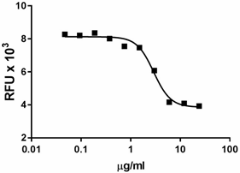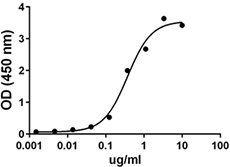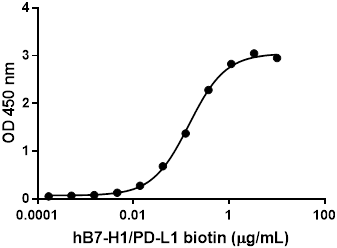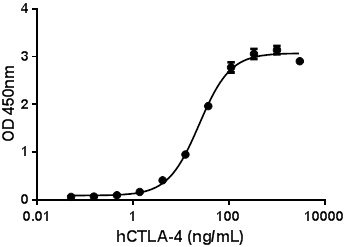- Regulatory Status
- RUO
- Other Names
- B7 Homolog 4, B7 Superfamily Member 1 (B7S1), Immune Costimulatory Protein B7-H4 (B7-H4), V-Set Domain Containing T Cell Activation Inhibitor 1 (VCTN1), T Cell Costimulatory Molecule B7x (B7X)
- Ave. Rating
- Submit a Review
- Product Citations
- publications

-

Human recombinant B7-H4 inhibits the anti CD3-induced proliferation of activated human T cells. -

Stability testing for human B7- H4. Human B7- H4 was aliquoted in PBS at 0.2 mg/ml; one aliquot was kept at 4°C (control) and another was freeze-thawed four times (4 x freeze-thaws). After this procedure, the samples were tested by inhibition of anti CD3-induced proliferation of human activated T cells.
Human and mouse B7-H4 were identified by homology search in mouse and human EST databases; B7h and B7-H3 amino acid sequences were used for the screening. B7-H4 contains one immunoglobulin (Ig) Ig-like V and one Ig-like C domain in the extracellular domain, a transmembrane domain, and an intracellular domain. B7-H4 is expressed in antigen presented cell (APC), and its expression is downregulated in B cells after different stimulus (LPS, IL-4, anti-IgM, and anti-CD40). B7-H4 inhibits cell-cycle progression, proliferation, and cytokine production in CD4 and CD8 T cells. Experimental interference of B7-H4 signaling exacerbates autoimmune diseases such as rheumatoid arthritis and multiple sclerosis. In Type 1 diabetes (T1D) the presence of activated islet-specific T cells is the key feature of the associated autoimmune condition. B7-H4-Ig fusion protein inhibits the proliferation of islet-specific T1D T cell clones obtained from patients. In addition, T1D is considerably reduced in diabetes-susceptible NOD mice treated with B7-H4-Ig protein. High levels in sera of soluble B7-H4 have been detected patients with T1D. The metalloproteinase nardilysin (NRD1) was identified as the enzyme that mediates B7-H4 shedding and the potential cleavage site was described as K246 RRS249. B7-H4 is overexpressed in human cancers and frequently associated with negative clinical outcome. B7-H4 chimeric antigen receptor (CAR) T cell therapy was applied in a mouse model; B7-H4 CAR T cells lysed B7-H4+ targets and presented antitumor activity in vivo against B7-H4+ human ovarian tumor xenografts.
Product DetailsProduct Details
- Source
- Human B7-H4 amino acids (Phe29-Ala258) (Accession # Q7Z7D3) was expressed in CHO cells.The carboxy terminus contains Fc-6His tag.
- Molecular Mass
- The 475 amino acid recombinant protein has a predicted molecular mass of approximately 53.0 kD. The DTT-reduced and non-reduced protein migrate at approximately 70kD and 140kD respectively by SDS-PAGE. The predicted N-terminal amino acid is Phe.
- Purity
- > 95% by SDS-PAGE gel as determined by Coomassie stained SDS-PAGE.
- Formulation
- 0.22 µm filtered protein solution is in PBS pH 7.2.
- Endotoxin Level
- Less than 0.1 EU per µg cytokine as determined by the LAL method.
- Concentration
- 10 and 25 µg sizes are bottled at 200 µg/mL. 100 µg size and larger sizes are lot-specific and bottled at the concentration indicated on the vial. To obtain lot-specific concentration and expiration, please enter the lot number in our Certificate of Analysis online tool.
- Storage & Handling
- Unopened vial can be stored between 2°C and 8°C for up to 2 weeks, at -20°C for up to six months, or at -70°C or colder until the expiration date. For maximum results, quick spin vial prior to opening. The protein can be aliquoted and stored at -20°C or colder. Stock solutions can also be prepared at 50 - 100 µg/mL in appropriate sterile buffer, carrier protein such as 0.2 - 1% BSA or HSA can be added when preparing the stock solution. Aliquots can be stored between 2°C and 8°C for up to one week and stored at -20°C or colder for up to 3 months. Avoid repeated freeze/thaw cycles.
- Activity
- Human recombinant B7-H4 inhibits the anti CD3 (Cat. No. 317303)-induced proliferation of activated human T cells; the inhibitory effect was measured using Deep Blue Cell Viability™ Kit (Cat. No. 424701). The ED50 = 0.8 - 4 µg/ml.
- Application
-
Bioassay
- Application Notes
-
BioLegend carrier-free recombinant proteins provided in liquid format are shipped on blue-ice. Our comparison testing data indicates that when handled and stored as recommended, the liquid format has equal or better stability and shelf-life compared to commercially available lyophilized proteins after reconstitution. Our liquid proteins are verified in-house to maintain activity after shipping on blue ice and are backed by our 100% satisfaction guarantee. If you have any concerns, contact us at tech@biolegend.com.
Antigen Details
- Structure
- Dimer
- Distribution
-
Antigen presenting cells (dendritic cells, peritoneal macrophages, and splenic B cells), epithelium of normal tissues breast, pancreas, and kidney, and some tumor cells derived from mammary, ovary, and uterus.
- Function
- B7- H4 inhibits T cell activation, proliferation, and cytokine production. B7-H4 is downregulated after B cell activation and induced by L-10 and TGF-β in peritoneal macrophages.
- Interaction
- Activated T cells
- Bioactivity
- Human recombinant B7-H4 inhibits the anti CD3-induced proliferation of activated human T cells.
- Biology Area
- Costimulatory Molecules, Immunology
- Molecular Family
- Soluble Receptors
- Antigen References
-
- Prasad DV, et al. 2003. Immunity. 18:863.
- Zang X, et al. 2003. PNAS. 100:10388.
- Ou D, et al. 2006. Cell Transplant. 15:399.
- Azuma T, et al. 2009. PLoS Med. 6(10):e1000166.
- Wei J, et al. 2011. J Exp Med. 208:1683.
- Radichev IA, et al. 2014. Diabetes. 63:3470.
- Smith JB, et al. 2016. Mol Ther. 24:1987.
- Podojil JR, Miller SD. 2017. Immunol Rev. 276:40.
- Gene ID
- 79679 View all products for this Gene ID
- UniProt
- View information about B7-H4 on UniProt.org
Related Pages & Pathways
Pages
Related FAQs
- Why choose BioLegend recombinant proteins?
-
• Each lot of product is quality-tested for bioactivity as indicated on the data sheet.
• Greater than 95% Purity or higher, tested on every lot of product.
• 100% Satisfaction Guarantee for quality performance, stability, and consistency.
• Ready-to-use liquid format saves time and reduces challenges associated with reconstitution.
• Bulk and customization available. Contact us.
• Learn more about our Recombinant Proteins. - How does the activity of your recombinant proteins compare to competitors?
-
We quality control each and every lot of recombinant protein. Not only do we check its bioactivity, but we also compare it against other commercially available recombinant proteins. We make sure each recombinant protein’s activity is at least as good as or better than the competition’s. In order to provide you with the best possible product, we ensure that our testing process is rigorous and thorough. If you’re curious and eager to make the switch to BioLegend recombinants, contact your sales representative today!
- What is the specific activity or ED50 of my recombinant protein?
-
The specific activity range of the protein is indicated on the product datasheets. Because the exact activity values on a per unit basis can largely fluctuate depending on a number of factors, including the nature of the assay, cell density, age of cells/passage number, culture media used, and end user technique, the specific activity is best defined as a range and we guarantee the specific activity of all our lots will be within the range indicated on the datasheet. Please note this only applies to recombinants labeled for use in bioassays. ELISA standard recombinant proteins are not recommended for bioassay usage as they are not tested for these applications.
- Have your recombinants been tested for stability?
-
Our testing shows that the recombinant proteins are able to withstand room temperature for a week without losing activity. In addition the recombinant proteins were also found to withstand four cycles of freeze and thaw without losing activity.
- Does specific activity of a recombinant protein vary between lots?
-
Specific activity will vary for each lot and for the type of experiment that is done to validate it, but all passed lots will have activity within the established ED50 range for the product and we guarantee that our products will have lot-to-lot consistency. Please conduct an experiment-specific validation to find the optimal ED50 for your system.
- How do you convert activity as an ED50 in ng/ml to a specific activity in Units/mg?
-
Use formula Specific activity (Units/mg) = 10^6/ ED50 (ng/mL)

 Login / Register
Login / Register 












Follow Us